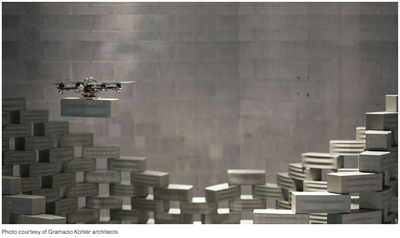 Inside Unmanned Systems’ Vicki Speed recently posted an in-depth article titled “Building Enthusiasm for Construction Robotics” on the use of robots and unmanned (guess we will have “unwomanned” bots and drones soon as well in the new PC world we live in) robots in the construction Industry.
Inside Unmanned Systems’ Vicki Speed recently posted an in-depth article titled “Building Enthusiasm for Construction Robotics” on the use of robots and unmanned (guess we will have “unwomanned” bots and drones soon as well in the new PC world we live in) robots in the construction Industry.
Speed talks about the use of robots in three areas today. First, robots have been used to “tear ‘em down” in the demolition of existing structures, in military threats, and in areas of the world where natural disasters have created dangerous conditions for humans, for over a decade much to our advantage. She points out that, “Omer Haciomeroglu, a student at Sweden’s Umea Institute of Design recently designed a concept model for a highly energy efficient, robotic demolition system, called the ERO Concrete Recycling Robot. The ERO system would automate building demolition, as well as building material reclamation and waste disposal.”
I guess we could call that one the “chew it up and spit it out” model for robotic demolition?
What about build’em up robots? Speed writes:
The Semi-Automated Masonry (SAM) system from Construction Robotics is a bricklaying robot designed to work alongside a mason.” As SAM lifts and places the bricks, the mason focuses on site setup, tooling joints and finishing/quality control. SAM can lay roughly 230 bricks an hour and can handle brick sizes from modular to utility. In late 2014, a masonry contractor tested SAM on a barracks construction project at Fort Lee. The firm expects to produce a limited release of three SAM systems this year.
Similarly, the Future Cities Laboratory (FCL) of the Singapore-ETH Centre, in collaboration with its partner, ROB Technologies AG, is developing a robotic tiling machine. The robotic tiling machine prototype was tested by the Housing Development Board of Singapore at a public housing project construction site. A spokesperson for the Future Cities Laboratory believes the commercial version of the robotic tiling machine will be able to deliver an up to four-fold increase in productivity. A semi-autonomous robotic tiling machine is expected by the end of 2015.
So, that is chew’em up and spit’em out, bricklaying, and tiling robots. What else?
We have heard about the bionic worker assisted suits that will further reduce the wear and tear on human workers. Whether mechanical or robotic, these new devices will ease some of the burden on our workforce, and where we do not have enough workers, we will be using robots to fill in the gaps, both figuratively and literally in the construction industry.
I recently read about a team at MIT that has developed a team of robots who can build block walls. Just last week, I read about a robot that can create smaller robots that can do specific tasks, gather information from each of the prototypes, and then incorporate those characteristics into the next gen of similar robots. I don’t think that most of us in the industry who are “nose down” involved with bidding and building new or “reno” projects have any idea what is headed our way in the form of new designs, new structures, and new technologies to build those new buildings.
Remember that AGC has told us that by 2030 we will need to replace every building standing today and accommodate a doubling of the capacity. The new technologies can help or hinder us in that process. Our smarter colleagues, and even the government, will be on the leading or “bleeding” edge of the change.
What are you doing on your jobsite to accommodate the change? Most of us still can’t tell you the inspectors who are working on our projects on any given day. Slow to adapt, super safe, and cautious are we. Something will have to change our approach or we will lag far behind: either to be run over or out run by the new technologies.


